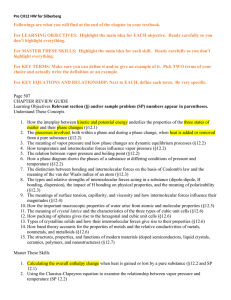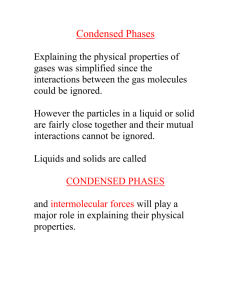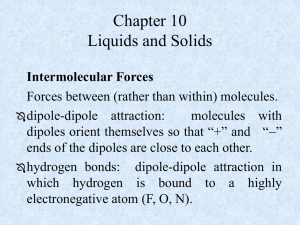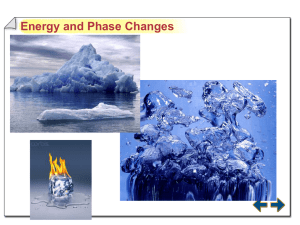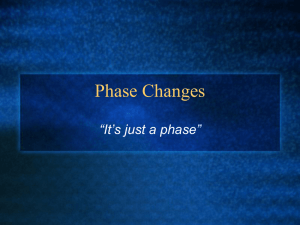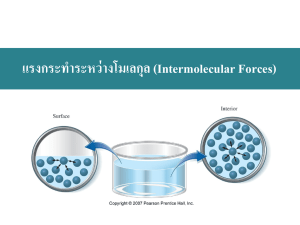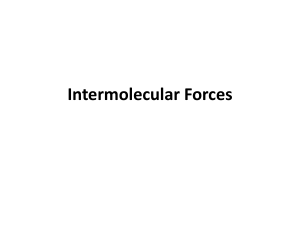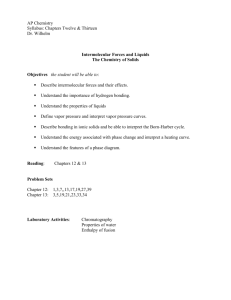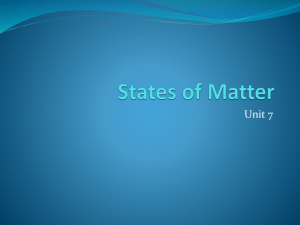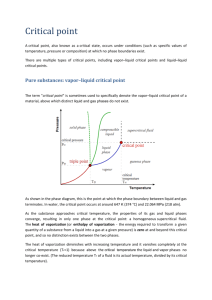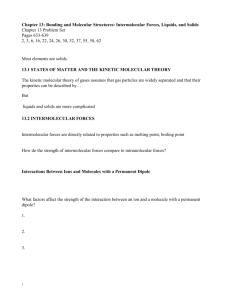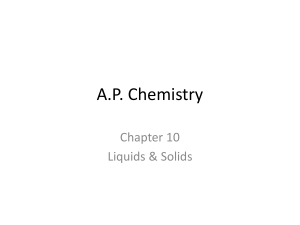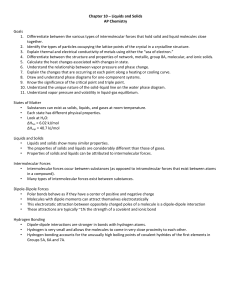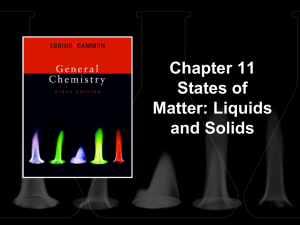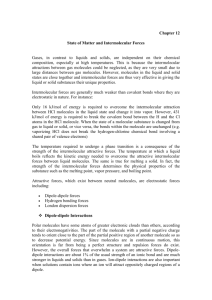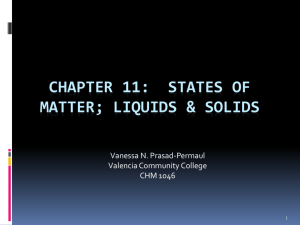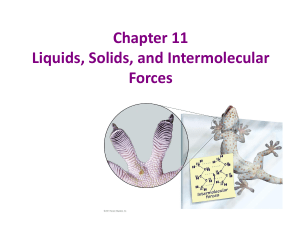AP Chapter Eleven Outline
advertisement
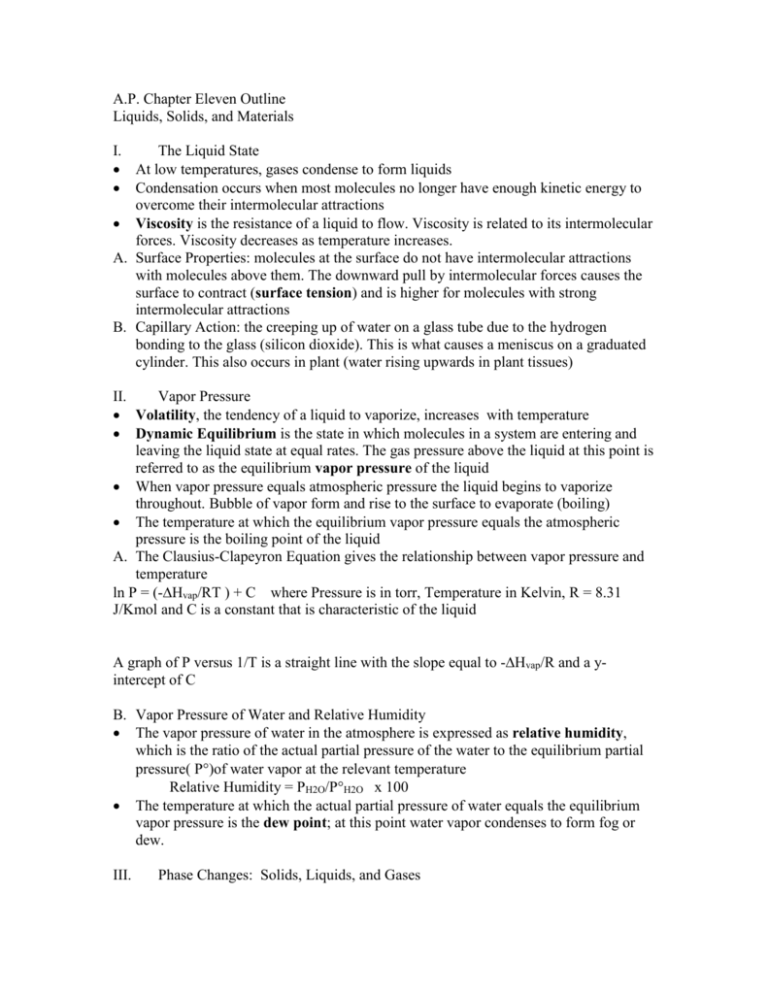
A.P. Chapter Eleven Outline Liquids, Solids, and Materials I. The Liquid State At low temperatures, gases condense to form liquids Condensation occurs when most molecules no longer have enough kinetic energy to overcome their intermolecular attractions Viscosity is the resistance of a liquid to flow. Viscosity is related to its intermolecular forces. Viscosity decreases as temperature increases. A. Surface Properties: molecules at the surface do not have intermolecular attractions with molecules above them. The downward pull by intermolecular forces causes the surface to contract (surface tension) and is higher for molecules with strong intermolecular attractions B. Capillary Action: the creeping up of water on a glass tube due to the hydrogen bonding to the glass (silicon dioxide). This is what causes a meniscus on a graduated cylinder. This also occurs in plant (water rising upwards in plant tissues) II. Vapor Pressure Volatility, the tendency of a liquid to vaporize, increases with temperature Dynamic Equilibrium is the state in which molecules in a system are entering and leaving the liquid state at equal rates. The gas pressure above the liquid at this point is referred to as the equilibrium vapor pressure of the liquid When vapor pressure equals atmospheric pressure the liquid begins to vaporize throughout. Bubble of vapor form and rise to the surface to evaporate (boiling) The temperature at which the equilibrium vapor pressure equals the atmospheric pressure is the boiling point of the liquid A. The Clausius-Clapeyron Equation gives the relationship between vapor pressure and temperature ln P = (-Hvap/RT ) + C where Pressure is in torr, Temperature in Kelvin, R = 8.31 J/Kmol and C is a constant that is characteristic of the liquid A graph of P versus 1/T is a straight line with the slope equal to -Hvap/R and a yintercept of C B. Vapor Pressure of Water and Relative Humidity The vapor pressure of water in the atmosphere is expressed as relative humidity, which is the ratio of the actual partial pressure of the water to the equilibrium partial pressure( P)of water vapor at the relevant temperature Relative Humidity = PH2O/PH2O x 100 The temperature at which the actual partial pressure of water equals the equilibrium vapor pressure is the dew point; at this point water vapor condenses to form fog or dew. III. Phase Changes: Solids, Liquids, and Gases A. Vaporization (Evaporation) occurs when a liquid molecule at the surface has more kinetic energy than the potential energy of intermolecular attractions. This is an endothermic process and the enthalpy change is called the heat of vaporization B. Condensation is when gas molecules reenter the liquid phase and is an exothermic process C. Melting requires transfer of energy, the heat of fusion, so it always endothermic D. The reverse of melting, solidification, freezing, or crystallization, is always an exothermic process E. Sublimation is the process in which atoms or molecules escape directly from the solid to gas phase F. Deposition is the process in which a gas is converted directly to a solid A plot of the temperature of a substance versus the heat added is called a heating curve Phase diagrams represent the three phases and the six interconversions among them The Triple Point is the point at which all three phases are in equilibrium The Critical Temperature, Tc, is the point at which any temperature above the molecules will not be a liquid but becomes a supercritical fluid The conditions at the critical point are the critical pressure and critical temperature IV. Water Ice floats Unique capacity for hydrogen bonding Extremely high heat capacity, heat of fusion, heat of vaporization, surface tension, and thermal conductivity V. Types of Solids Ionic Metallic Molecular Network (graphite, diamond, mica) Amorphous (glassy) VI. Crystalline Solids A unit cell is the smallest part of the lattice that is representative Cubic unit cells have edges of equal length meeting at 90 - simple cubic (sc): 1 atom per simple cubic unit cell; 2(atomic radius) = edge - body centered cubic (bcc): two atoms per body centered cubic unit cell; 4(atomic radius) = edge(3)1/2 - face centered cubic (fcc): four atoms per face centered cubic unit cell; 4(atomic radius) = edge(2)1/2 * Closest packing is the arrangement in crystalline solids to maximize interactions

